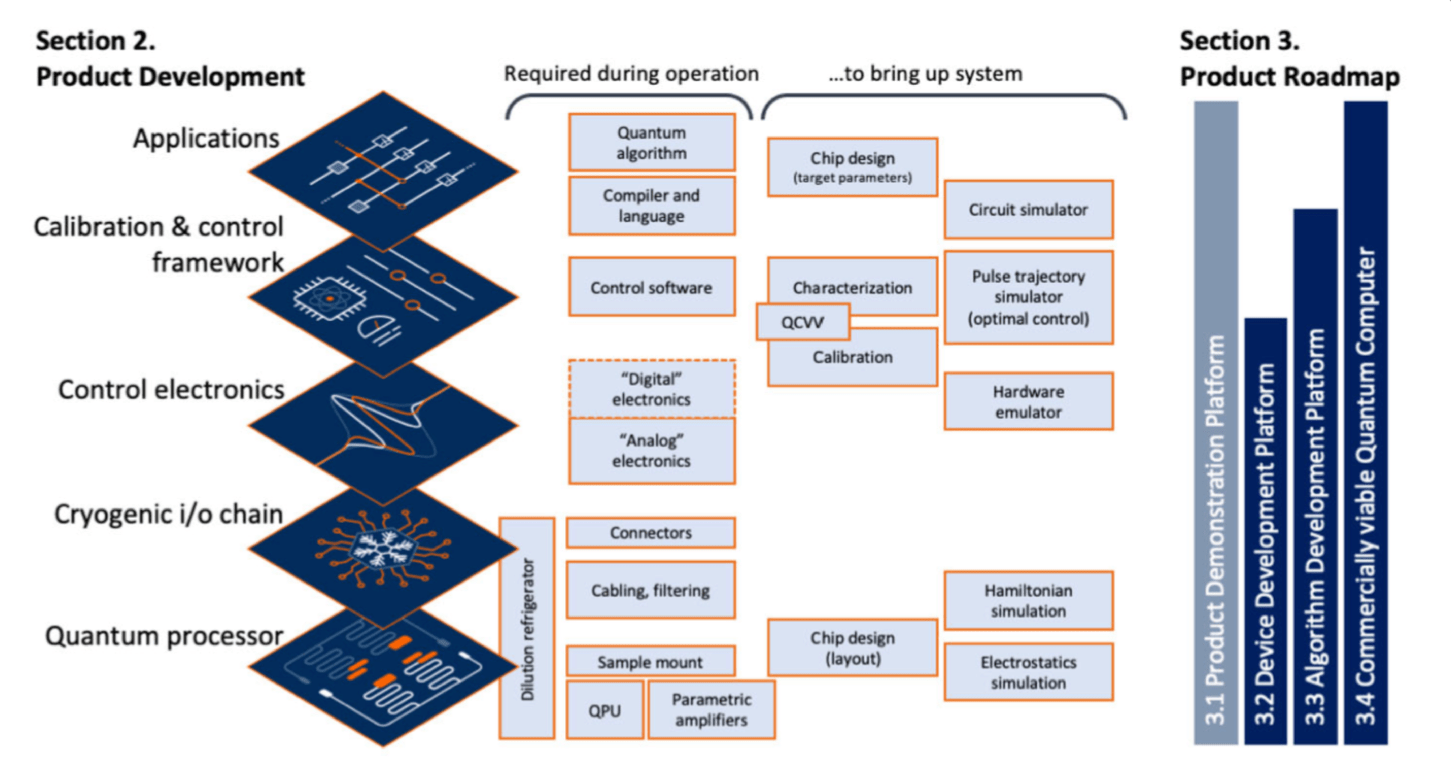Towards a Commercial Quantum Computer: A Dutch Roadmap

(By Amara Graps, Staff Writer) To summarize what is needed in a supply chain for the key components for a consumer Quantum Computer product, the Dutch quantum ecosystem formed the ImpaQT project, with their first task: the development of a Roadmap. For such a roadmap one needs a standardization and integration of all of its building blocks, with a mature supply chain that can provide high-quality components and can ensure a security of supply.
The ImpaQT team says that the product development approach puts a focus on the functionality and performance requirements. A product development approach, however, needs a systems engineering approach. According to the ImpaQT project, the consumer Quantum Computer product should meet the following Requirements:
- Requirement 1: Provide solutions for commercially interesting problems
- Requirement 2: Enable the development and execution of NISQ applications
- Requirement 3: Enable the development of quantum processors
- Requirement 4: Tune-up the performance of Quantum Devices
Commercial Quantum Computer Roadmap-at-a-Glance: With the Roadmap separating product development into these components:
- Quantum processor
- Cryogenic i/o chain
- Control electronics
- Calibration and control framework
- Applications
This approach breaks down the components further into those “required during operation” and those “required to bring up the system”.
Main Commercial Quantum Computer Roadmap Components: Attached to the Quantum Processor, we see Chip design, Hamiltonian and Electrostatic simulation to ‘bring up the system’ with components ‘required during operation’ as QPU, Parametric amplifiers, sample mount, cabling, filtering, and connectors.
Attached to the Applications, we see: Chip design and Circuit simulator as required to ‘bring up the system’, with Quantum Algorithms and Compiler and language as ‘required during operation’.
Attached to the Calibration and control framework, we see that ‘Control Software‘ is required ‘during operation’, with those components required to ‘bring up the system’ listed as: ‘Characterization‘, ‘Calibration‘, ‘Quantum Computer Verification and Validation’ (QCVV) components, and several simulators, such as a ‘Pulse trajectory simulator‘.
Despite the ImpaQT project authors’ claim that such a commercial quantum computer is still a decade off, there is power in a clean vision. This end-user product-focused Roadmap can carry the pointers to the Gaps and Roadmaps — an ’embedded’ Roadmap– of the other components in the forthcoming years, while guiding the commercial quantum computer field as a whole.
Inside the Commercial Quantum Computer Roadmap: More Roadmaps
A Quantum Computer Verification and Validation’ (QCVV) Protocol: Q-RBPN: QCVV achieved a milestone in August 2021 with the publication: ‘Single-Qubit Cross Platform Comparison of Quantum Computing Hardware‘ by Adrien Suau and colleagues. Their work provides a protocol, called Q-RBPN for ‘Qubit Response, Bias, Positive saturation, Negative saturation’ to measure four basic properties of the qubits in quantum hardware platforms.
The proposed Q-RBPN protocol scales to large quantum computers with thousands of qubits and provides insights into the distribution of qubit properties within a particular hardware device and across families of devices. For the first time, there is a protocol, which can provide a side-by-side comparison of single-qubit performance across the Quantum Computing (IBM-Q) and Quantum Annealing (D-Wave Systems) hardware platforms.
Chip Design Roadmap: The Quantum processor component in the ImpaQT Roadmap. We can embed the February 2021 ‘Roadmap on quantum nanotechnologies‘ by Arne Laucht and colleagues to the Chip design component ‘to bring up the system’ with the adjacent components required ‘during operation’. This very comprehensive review, for quantum processors, provides the status of quantum devices used for quantum metrology and sensing, as building blocks for quantum computing, and as sources and detectors for quantum communication.
NISQ Algorithms Roadmap: The Algorithms component in the ImpaQT Roadmap. We can embed the January 2021 ‘Noisy intermediate-scale quantum (NISQ) algorithms‘ review by Kishor Bharti and colleagues to the Quantum algorithm and Compiler and language components to ‘bring up the system’ for applications in various disciplines spanning physics, machine learning, quantum chemistry and combinatorial optimization. Their review discusses their limitations, and advantages with additional benchmarking and software tools useful for programming and testing NISQ devices.
With these examples, we see how such an ImpaQT Roadmap framework can help the community to reach a commercial quantum computer. We invite more suggestions.
 Figure 1: A full stack quantum computer consists of many different components that need to work seamlessly together. A simplified version of such a stack for a quantum system based on superconducting devices is illustrated in the figure on the left. In Section 2 we review the status of the technology with a focus on those superconducting systems and use this, together with the customer needs to derive product requirements and specifications. On the right, we show the different products in the product roadmap and what parts of the stack these products relate to. In Section 3, we describe the product roadmap with the different products that need to be developed to meet the requirements and specifications.
Figure 1: A full stack quantum computer consists of many different components that need to work seamlessly together. A simplified version of such a stack for a quantum system based on superconducting devices is illustrated in the figure on the left. In Section 2 we review the status of the technology with a focus on those superconducting systems and use this, together with the customer needs to derive product requirements and specifications. On the right, we show the different products in the product roadmap and what parts of the stack these products relate to. In Section 3, we describe the product roadmap with the different products that need to be developed to meet the requirements and specifications.



















